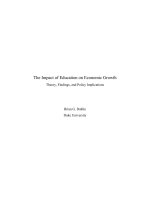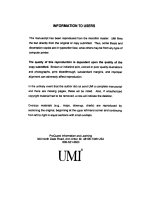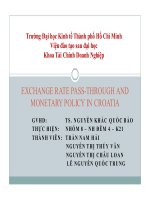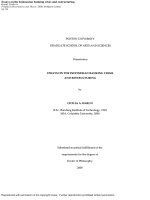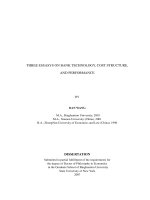essays on income inequality exchange rate and policy coordination
Bạn đang xem bản rút gọn của tài liệu. Xem và tải ngay bản đầy đủ của tài liệu tại đây (1.14 MB, 241 trang )
Copyright
by
Xiaojun Yang
2003
The Dissertation Committee for Xiaojun Yang Certifies that this is the
approved version of the following dissertation:
Essays on Income Inequality, Exchange Rate,
and Policy Coordination
Committee:
David A. Kendrick, Supervisor
Li Gan
Vince Geraci
William Glade
Hong Yan
Essays on Income Inequality, Exchange Rate,
and Policy Coordination
by
Xiaojun Yang, B.A., M.I.A., M.S.
Dissertation
Presented to the Faculty of the Graduate School of
The University of Texas at Austin
in Partial Fulfillment
of the Requirements
for the Degree of
Doctor of Philosophy
The University of Texas at Austin
May 2003
UMI Number: 3116243
________________________________________________________
UMI Microform 3116243
Copyright 2004 by ProQuest Information and Learning Company.
All rights reserved. This microform edition is protected against
unauthorized copying under Title 17, United States Code.
____________________________________________________________
ProQuest Information and Learning Company
300 North Zeeb Road
PO Box 1346
Ann Arbor, MI 48106-1346
iv
Acknowledgements
I am deeply indebted to my supervisor Professor David A. Kendrick for
his kind guidance, advice and encouragement. Under his consistent,
conscientious and patient supervision, I have gained insight about
macroeconomics and computational economics, importantly how to approach
academic research. I will continue to value his friendship.
I also owe thanks to the other member of the dissertation committee: Dr.
Li Gan, Dr. Vince Geraci, Dr. William Glade, Dr. Hong Yan, for their valuable
discussions and suggestions, and for their generosity and kindness. Also, I would
like to express my appreciation to Seung-Rae Kim and Marco Tucci for their
intellectual and technical advice.
Finally, I express my special thanks to my parents for their lasting support
and love.
v
Essays on Income inequality, Exchange Rate,
and Policy Coordination
Publication No._____________
Xiaojun Yang, Ph.D.
The University of Texas at Austin, 2003
Supervisor: David A. Kendrick
The goal of this dissertation is to develop and to use computational
methods to study issues in policy coordination, exchange rates and income
inequality.
The topic of policy formulation among interdependent economies has
received much attention in the literature. In the first essay a two-country model is
used to illustrate the interdependence of China’s and Hong Kong’s economies.
Not surprising, we find that the policy effect is asymmetric, due to difference in
size. Shocks to the Chinese economy will affect Hong Kong’s stable economic
growth. In order for Hong Kong to keep a stable growth, both governments must
act in certain ways. Particularly, by importing more China can help Hong Kong’s
economy, especially during the financial crisis years. We find that fiscal policy is
vi
more effective than monetary policy in affecting economic activities in this
model.
In the second essay, we develop a model to study the behavior of the
Yuan/Dollar exchange rate. The parameter values estimated for the model are
such that when China increases its relative money supply, the exchange rate
appreciates, which is different than the conventional result. Also the parameter
values indicate that in order for China to have a higher level of GDP, China has to
increase its money supply; and for a stable exchange rate, China either decreases
its money supply then increases it or increases its money supply during the entire
period. The right policy hinges on the desired path for the exchange rate. Since
the model is simple in essence, the results should be interpreted with caution.
The third essay analyses the contribution of different factors to the
determination of income inequality. The questions regarding whether greater
income inequality is conducive to China's growth and the role of degree of reform
for growth and inequality have been studied in the paper. We find a positive
correlation between income inequality and growth, that reform plays a dominant
role in determining growth and income inequality, and that steady growth can not
be emphasized too much, otherwise the reform process will be reversed, which is
not practical. Finally, the tradeoff between income inequality and growth is
analyzed.
vii
Table of Contents
Chapter One: Introduction 1
Chapter Two: Economic Interaction and Policy Coordination Between China
and Hong Kong 3
2.1 Introduction 3
2.2 The Model 4
2.3 The Optimal Control Theory 10
2.4 The Model with Price Variables 32
2.4.1 The Model Equations… 32
2.4.2 Simulations 39
2.4.2.1 Historical Simulation 39
2.4.2.2 Policy Simulation 43
2.4.2.2.1 Fiscal Expansion 43
2.4.2.2.2 Monetary Expansion 49
2.5 The Model with Price Variables in the Control Theory Framework 50
Chapter Three: Yuan - Dollar Exchange Rate Model 62
3.1 Introduction 62
3.2 Developments of China's Foreign Exchange System 63
3.3 The Model 71
3.3.1 The Model Equations… 72
3.3.2 Data 74
3.3.3 Estimation 75
3.3.4 Policy Simulation 77
3.4 The Control 82
3.4.1 The Control Framework 82
3.4.2 Results and Experiments 86
viii
3.5 Conclusion 95
Chapter Four: Reform, Inequality, and Growth 96
4.1 Introduction 96
4.2 Factor Consideration 97
4.3 The Model 102
4.4 Control and Sensitivity Analyses 112
4.4.1 The Control Framework 112
4.4.2 Sensitivity Analysis 117
4.4.2.1 Sensitivity Analysis from 1991 to 1998 119
4.4.2.2 Sensitivity Analysis from 1998 to 2010 132
4.4.2.2.1 Caring More about Income Inequality 135
4.4.2.2.2 Caring More about Growth Rate 140
4.4.2.2.3 Greater Difficulty to Further Reform 144
4.4.2.2.4 Inequality verse Growth 149
4.5 Conclusion 152
Appendix A-1 Historical Simulation 154
Appendix A-2 Simulation Results for China's Fiscal Expansion 158
Appendix A-3 Duali Input File 1 162
Appendix A-4 Duali Input File 2 179
Appendix B-1 Comparison of Different Money Supply 198
Appendix B-2 Duali Input File 199
Appendix C-1 Constant Inequality, Growth and Inflation 204
Appendix C-2 Duali Input File 206
Appendix D-1 Data-China 212
Appendix D-2 Data-Hong Kong 220
ix
Appendix D-3 Data-US 226
Bibliography 228
Vita 231
1
Chapter 1: Introduction
The topic of policy formulation among interdependent economies has
received much attention in the literature. China and Hong Kong are economically
closely linked. Policy initiatives in one economy may influence the evolution of
economics variables in the other. In the first essay a two-country model is used to
illustrate the interdependence of these two economies. Not surprisingly, we found
that the policy effects are asymmetric, due to differences in size. China’s
economic policies have a big effect on Hong Kong, but the reverse is not true.
However, China and Hong Kong’s economies are intertwined. A shock to the
Chinese economy will affect Hong Kong’s stable economic growth. In order for
Hong Kong to keep a stable growth, both governments must act in certain ways.
Particularly, by importing more China can help Hong Kong’s economy, especially
during financial crisis years. In doing so, China has to have higher government
expenditure and Hong Kong has to have higher money growth. At the same time,
Hong Kong should steadily increase its government expenditure and China should
keep a stable money growth. Fiscal policy is more effective than monetary policy
in affecting economic activities in this model.
In the second essay, we develop a model to study the behavior of the
Yuan/Dollar exchange rate. We connect the exchange rate with China and
America’s income, money supply, interest rate, and current account. The
parameter values estimated for the model are such that when China increases its
2
relative money supply, the exchange rate appreciates. Also the parameter values
indicate that in order for China to have a higher level of GDP, China has to
increase its money supply; and for a stable exchange rate, China can either
decrease its money supply then increases it or increase its money supply during
the entire period. The correct policy depends on the desired path of the exchange
rate. Since the model is simple in essence, the results should be interpreted with
caution.
The reform and open-door policies in China have liberated people’s work
incentive and enthusiasm. Important aspects of this change are that people have
more job choices and more opportunities, and that income inequality has
increased. The final chapter analyses the contribution of different factors in the
determination of income inequality. The questions regarding whether income
inequality is conducive to China's growth and the role of degree of reform for
growth and inequality have been studied in the paper. A two-period model with
two-group households—rural and urban—is introduced to illustrate factors that
should be considered in income distribution and growth. Based on this
framework, equations are developed for urban income inequality, rural income
inequality, growth and inflation. Contradicting a popular view regarding East
Asian countries, a positive correlation between income inequality and growth was
found. The other findings are that reform plays a dominant role in determining
growth and income inequality, and that steady growth can not be emphasized too
much, otherwise the reform process will be reversed, which is not practical.
Finally, the tradeoff between income inequality and growth is analyzed.
3
Chapter 2: Economic Interaction and Policy Coordination
Between China and Hong Kong
2.1
I
NTRODUCTION
The economic reforms that took place in mainland China in the late 1970s
began a new process that fundamentally changed the economic relationship
between mainland China and Hong Kong. In the 1960s and 1970s, Hong Kong’s
economic growth rate reached, on average, almost 10 percent per year. However
by the early 1980s high land rents and wages began to erode Hong Kong’s
international competitiveness that had been the basis of its success.
Coincidentally, the emergence of such pressures coincided with China’s open-
door policies. Thus a mutual benefit situation arose between the two and the
forging of much closer economic relations began. We want to know how the two
economies interact, how policy interaction can increase their welfare, and what
policy instrument is more effective in affecting the economies. In this paper a
two-country model is used to illustrate the interdependence of these two
economies and also answer those questions. We found the policy effect is
asymmetric, due to different size. China’s economic policies have a big effect on
Hong Kong, but the reverse is not true. However, China and Hong Kong’s
economies are intertwined. The shock of the Chinese economy will affect Hong
Kong’s stable economic growth. In order for Hong Kong to keep a stable growth,
both governments must act in certain ways. China can help Hong Kong
government reduce expenditure without hurting Hong Kong’s economic growth.
4
Fiscal policy is more effective than monetary policy in affecting economic
activities.
The chapter is organized as follows. Section 2 describes the model. The
optimal control theory is presented in section 3, where we describe the quadratic
linear problem, give the solution process for the system, and associate the
dynamic optimization method with our problem. In section 4, the price variables
are added to the model to see the role of monetary policy, where we also present
policy simulations. Section 5 puts the expanded model in the control theory
framework and gives a sensitivity analyse.
2.2
T
HE
M
ODEL
2.2.1 The Model Setup
The model consists of the GDP identity and functions for each of its
components. Specifically, for the Chinese economy we have:
CY
t+1
= CC
t+1
+ CI
t+1
+ CG
t+1
+ CX
t+1
– CM
t+1
CC
t+1
= a
0
+ a
1
CC
t
+ a
2
CY
t+1
+ a
3
CY
t
CI
t+1
= b
0
+ b
1
CI
t
+ b
2
CY
t+1
+ b
3
CY
t
CM
t+1
= c
0
+ c
1
CM
t
+ c
2
CY
t+1
CX
t+1
= d
0
+ d
1
CXt + d
2
HY
t+1
where CY, CC, CI, CG, CX, and CM stand for China’s GDP, consumption,
investment, government expenditure, exports, and imports respectively;
5
For the Hong Kong economy we have:
HY
t+1
= HC
t+1
+ HI
t+1
+ HG
t+1
+ HX
t+1
– HM
t+1
HC
t+1
= e
0
+ e
1
HC
t
+ e
2
HY
t+1
HI
t+1
= f
0
+ f
1
HI
t
+ f
2
HY
t+1
+ f
3
HY
t
HM
t+1
= g
0
+ g
1
HY
t
+ g
2
HY
t+1
HX
t+1
= h
0
+ h
1
CYt + h
2
CY
t+1
where HY, HC, HI, HG, HX, and HM stand for Hong Kong’s GDP,
consumption, investment, government expenditure, exports, and imports
respectively. Economic theory has little to say about the lag structure, and the lag
variables are included in the stochastic equations, since they result in a better fit
of the model to the data.
Since all the endogenous variables are interrelated between China and
Hong Kong as well as within each economy, we use two-stage least squares to
estimate the model. We use all the relevant variables as the instrumental
variables. When the Durbin-Watson statistic indicates a first-order serial
correlation, we use the Cochrane-Orcutt technique to correct it.
The following is the estimation result
1
:
For the Chinese economy:
CY
t+1
= CC
t+1
+ CI
t+1
+ CG
t+1
+ CX
t+1
– CM
t+1
1
The data we used is from “Statistical Yearbook of China” from 1987 to 2001 by SSB.
6
CC
t+1
= -6402 + 0.85 CC
t
+ 0.48 CY
t+1
- 0.4 CY
t
(11300) (0.26) (0.044) (0.14) R
2
= 0.99
CI
t+1
= 10660 + 0.65 CI
t
+ 0.46CY
t+1
– 0.35 CY
t
(9863) (0.22) (0.045) (0.1) R
2
= 0.98
CM
t+1
= -8486 + 0.75 CM
t
+ 0.07 CY
t+1
(13960) (0.39) (0.068) R
2
= 0.8
CX
t+1
= -10677 + 0.9 CX
t
+ 0.3 HY
t+1
(19072) (0.22) (0.3) R
2
= 0.93
For the Hong Kong economy:
HY
t+1
= HC
t+1
+ HI
t+1
+ HG
t+1
+ HX
t+1
– HM
t+1
HC
t+1
= -2799 + 0.5 HC
t
+ 0.41 HY
t+1
(15177) (0.23) (0.15) R
2
= 0.99
HI
t+1
= -9118 + 0.42 HI
t
+ 0.74HY
t+1
– 0.5HY
t
(3901) (0.23) (0.13) (0.14) R
2
= 0.95
HM
t+1
= -28400 + 2.27HY
t+1
– 0.680 HY
t
(12419) (0.46) (0.41) R
2
= 0.95
HX
t+1
= 35263 + 0.4CY
t+1
- 0.216 CY
t
(24486) (0.19) (0.19) R
2
= 0.55
7
The standard errors are in parentheses. All the signs meet our expectation.
The interaction of the two economies is represented by the export functions:
China’s export is a function of Hong Kong’s GDP, and Hong Kong’s export is a
function of China’s GDP.
2.2.2 The Estimation Technique
2
This section describes a consistent estimator of a simultaneous-equations
model in which there is a lagged dependent variable and serial correlation.
Consider the following equations (in deviation form):
t1t3t2t
qapaq ε++=
−
(1)
t1tt
v
+ρε=ε
−
(2)
tt2t
uybp
+=
(3)
where u
t
and v
t
are independent over time and are uncorrelated with each other.
The first equation is identified and contains an autoregressive error term.
Plugging (2) into (1), we get
t2t1t31tt21tt
v)qq(a)pp(aqq
+ρ−+ρ−=ρ−
−−−−
(4)
Since
ρ
is not known, the estimate of the serial correlation coefficient, r, may not
equal
ρ
. Then (4) becomes
2
This section is heavily drawn from Pindyck and Rubinfeld (1998).
8
])r(v[)rqq(a)rpp(arqq
1tt2t1t31tt21tt −−−−−
ε−ρ++−+−=−
(5)
According to Fair, a consistent estimator can be obtained by the following
procedure.
Stage one: estimate the equation
t2t51t41t3t2t
wqpqyp
+γ+γ+γ+γ=
−−−
(6)
and get the predicted values p
ˆ
t.
Stage two: estimate the equation
]w
ˆ
a)r(v[
)rqq(a)rpp
ˆ
(arqq
t21tt
2t1t31tt21tt
+ε−ρ+
+−+−=−
−
−−−−
(7)
where
ttt
ppw
ˆˆ
−= , the residual from the first stage. The estimate of
ρ
can be
obtained via the Cochrane-Orcutt procedure.
The following figure is out of sample prediction based on above
estimation.
9
Figure 1.1 Actual verse Prediction
310
320
330
340
350
360
370
380
390
400
1997 1998 1999 2000
Panel a: China's Consumption
actual predicted
160
210
260
310
360
410
1997 1998 1999 2000
Panel b: China's Investment
actual predicted
0
20
40
60
80
100
120
140
160
180
1997 1998 1999 2000
Panel c: China's Im port
actual predicted
0
10
20
30
40
50
60
1997 1998 1999 2000
Panel e: Hong Kong's Investment
actual predicted
0
50
100
150
200
250
1997 1998 1999 2000
Panel e: Hong Kong's Import
actual predicted
64
66
68
70
72
74
76
78
80
82
84
86
1997 1998 1999 2000
Panel d: Hong Kong's Consumption
actual predicted
10
2.3
O
PTIMAL
C
ONTROL
T
HEORY
3
Many problems in economics are formulated as dynamic models. Control
theory is a dynamic optimization method, in which controls are used to move an
economic system over time from a less desirable to a more desirable state. The
basic idea of control theory is that an objective function is optimized subject to a
set of state or system equations. The objective function of a model depends on the
decision maker’s objectives. Variables in the system are separated into two
groups: state and control variables. The state of the economic system at any point
in time is represented by the state variables. Controls represent policy variables,
that can be altered by decision makers. The application of optimal control in
economics normally centers on a class of control problems called quadratic linear
tracking problems. The goal in the quadratic linear tracking problem is to cause
the state variables and control variables to follow their desired paths as closely as
possible. That is also the model we use in this study.
The objective function in the quadratic linear tracking problem is
)
~
()
~
(
2
1
'
NNNNN
xxWxxJ −−=
[]
∑
−
=
−Λ−+−−+
1
0
''
)
~
()
~
()
~
()
~
(
2
1
N
t
tttttttttt
uuuuxxWxx
and the system equations are in the structural form used by Pindyck (1973), i.e.
3
See Kendrick (1981) (2002) for discussion of control theory methods.
11
ttttt
zCuBxAxAx
111101
+++=
++
where
x
t
= state vector of period t
t
x
~
= desired path for the state vector
t
u = control vector of period t
t
u
~
= desired path for the control vector
z
t
= purely exogenous variable vector of period t
t
W = penalty weight matrix for the state vector which is a diagonal matrix
t
Λ = penalty weight matrix for the control vector which is a diagonal
matrix
A
0
, A
1
, B
1
, and C
1
are the coefficient matrices and vectors
To specify, in our model we have:
=
t
t
t
t
t
t
t
t
t
t
t
HM
HX
HI
HC
HY
CM
CX
CI
CC
CY
x ,
=
t
t
t
HGLead
CGLead
u ,
[]
Constz
t
= .
12
Since we are going to represent this model in Duali software written by Amman
and Kendrick (1999), and Duali software does not allow variables in concurrent
terms, we introduce Lead CG
t
and Lead HG
t
, where
Lead CG
t
= CG
t+1
Lead HG
t
= HG
t+1
−
−
=
000027.200000
0000000004.0
000074.000000
000041.000000
1111000000
00000000007.0
00003.000000
00000000046.0
00000000048.0
0000011110
0
A
13
−
−
−
−
−
=
00006.000000
000000000216.0
0042.005.000000
0005.0000000
0000000000
0000075.00000
0000009.0000
000000065.0035.0
0000000085.04.0
0000000000
1
A
=
00
00
00
00
10
00
00
00
00
01
1
B
−
−
−
−
−
=
28400
35263
9118
2799
0
8486
10677
10660
6402
0
1
C
The desired paths of all the state variables are computed using their average
growth value the same growth rate from 1987 to 2000 except for the control
variables which are from 1988 to 2000, for example, China’ GDP in 1987 and
2000 are 359 billion and 815 billion US dollars (both in 1990 price) respectively.
The growth rate of GDP during this period is 6.5 percent per year. The desired
14
path of China’s GDP then is calculated according the growth rate of 6.5% each
year. The desired paths are shown in Table 2.1.
Table 2.1: Desired Paths for the State and Control Variables
Year CY CC CI CX CM HY HC HI HX HM CG HG
1987
359 184 133 45 50 54 32 15 66 63
1988
383 195 142 51 55 58 34 16 72 68 51 4
1989
407 207 151 56 60 62 36 17 78 74 55 5
1990
434 219 160 63 66 66 39 18 84 80 58 5
1991
462 233 171 70 73 70 41 19 91 87 62 5
1992
492 247 181 79 80 74 44 21 98 94 66 6
1993
524 261 193 88 88 79 47 22 106 102 70 7
1994
558 277 205 98 97 84 49 23 115 111 74 7
1995
595 294 218 109 106 90 53 25 125 120 79 8
1996
633 312 232 122 117 96 56 26 135 130 84 8
1997
675 330 246 136 129 102 60 28 146 141 89 9
1998
719 350 262 152 141 109 63 30 158 153 95 10
1999
765 371 278 170 155 116 67 32 171 165 101 11
2000
815 394 296 189 171 123 72 34 185 179 107 12
Following Shih (1997), The penalty weights for the base case are chosen
according to:
)/(559 iofmeanW
i
=
Where 559 is the average for China’s GDP.
i: state variables or control variables.
For example, China’s consumption average from 1987 to 2000 is 277
billion dollars. The penalty weight for China’s consumption is 559 divided by
277, and which is about two. 559 is China’s GDP average, which is the largest
15
average value among all variables. We chose 559, since we want the penalty
weights to be greater than one.
Since variables in our model have different units, this normalization will
give the same importance on each variable. Sometimes the weights are
normalized with different methods, for example, normalized with squares.
Fonseca (1999) gave a detailed description about different normalization
approaches. Here we follow Shih (1997)’s method. This normalization is simple
to calculate and also it achieves normalization goal. The following table lists the
penalty weights.
Table 2.2: Penalty Weights on State and Control Variable
CY CC CI CX CM HY HC HI HX HM CG HG
1 2 2.7 5.5 5.6 6.6 11.3 24 4.8 5 7.9 80.5
In fact the quadratic linear tracking problem can be transformed to the
quadratic linear problem (QLP), as described in Kendrick (1981, page 6-8). The
quadratic linear problem (QLP) is to obtain the solution paths for all the relevant
variables by optimizing a quadratic objective function subject to system equations
and a given initial condition. The variables in the model are separated into two
groups: state and control variables. Kendrick (1981) states the QLP as to find
1
0
)(
−
=
N
kk
u to minimize the criterion (2.1) next page.



